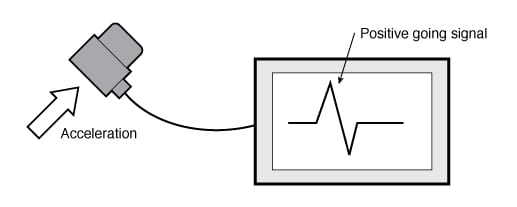Question
Can you explain the “output polarity†specification found on your piezoelectric accelerometer datasheets? How does this specification affect my measurements?
Answer
Output polarity describes the direction of an accelerometer output signal (whether it is positive or negative going), given a particular direction of the input acceleration. By convention, most accelerometers are specified such that, if the acceleration is directed into the mounting surface of the sensor, the output signal will be positive going. This is referred to as “positive polarity.â€
It is possible, however, to have a negative polarity accelerometer. The
Endevco® model 22 is a good example. So, always refer to the datasheet specification to be sure. When in doubt, a user can also easily test and verify output polarity. While holding the accelerometer in hand, and with it connected to all proper signal conditioning, tap the mounting surface with a finger (orientation of the accelerometer is irrelevant). Observe which direction the resultant signal goes (using an oscilloscope). If it is a positive polarity accelerometer, the signal should go positive, as illustrated in the figure below:

Output polarity of a triaxial accelerometer is slightly less straightforward. In most cases, the manufacturer will mark arrows for each orthogonal direction (X, Y and Z), indicating the direction the acceleration would have to be for a positive going signal to result.
Correctly interpreting output polarity is critical in certain applications. For example, in a modal test on a large structure, it is essential to understand the directions and phase relationships of the acceleration vectors that the structure is exhibiting during vibration excitation. Without having a correct understanding of accelerometer polarity, acceleration vector directions would be unknown and little-to-no understanding of structural behavior would be gained.